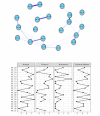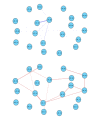Addiction Symptom Network of Young Internet Users: Network Analysis
- PMID: 36355402
- PMCID: PMC9693725
- DOI: 10.2196/38984
Addiction Symptom Network of Young Internet Users: Network Analysis
Abstract
Background: An increasing number of people are becoming addicted to the internet as a result of overuse. The Internet Addiction Test (IAT) is a popular tool for evaluating internet use behaviors. The interaction between different symptoms and the relationship between IAT and clinical diagnostic criteria are not well understood.
Objective: This study aimed to explore the core symptoms of internet addiction (IA) and the correlation between different symptoms of the IA symptom network. Network analysis was also conducted to explore the association between the IAT scale and the Diagnostic and Statistical Manual of Mental Disorders-5th edition (DSM-5) criteria for IA.
Methods: We recruited 4480 internet users (aged 14-24 years), and they completed the IAT. The final analysis included 63.50% (2845/4480) of the participants after screening the submitted questionnaires. Participants were classified into IA group and non-IA (NIA) group. By using partial correlation with Lasso regularization networks, we identified the core symptoms of IA in each group and compared the group differences in network properties (strength, closeness, and betweenness). Then, we analyzed the symptom networks of the DSM-5 diagnostic criteria and IAT scale for IA.
Results: A total of 12.47% (355/2845) of the patients were in the IA group and 87.52% (2490/2845) of the patients were in the NIA group, and both groups were evaluated for the following nodes: IAT_06 (school work suffers; strength=0.511), IAT_08 (job performance suffers; strength=0.531), IAT_15 (fantasize about being on the web; strength=0.474), IAT_17 (fail to stop being on the web; strength=0.526), and IAT_12 (fear about boredom if offline; strength=0.502). The IA groups had a stronger edge between IAT_09 (defensive or secretive about being on the web) and IAT_18 (hidden web time) than the NIA groups. The items in DSM-5 had a strong association with IAT_12 (weight=-0.066), IAT_15 (weight=-0.081), IAT_17 (weight=-0.106), IAT_09 (weight=-0.198), and IAT_18 (weight=-0.052).
Conclusions: The internet use symptom network of the IA group is significantly different from that of the NIA group. Nodes IAT_06 (school work affected) and IAT_08 (work performance affected) are the resulting symptoms affected by other symptoms, whereas nodes IAT_12 (fear about boredom if offline), IAT_17 (inability to stop being on the web), and IAT_15 (fantasize about being on the web) are key symptoms that activate other symptoms of IA and are strongly linked to the inability to control the intention to play games in the DSM-5.
Keywords: Internet Addiction Test; adolescents; internet addiction; network analysis.
©Jianxia Lu, Qinhan Zhang, Na Zhong, Jin Chen, Yujia Zhai, Lei Guo, Chunlei Lu, Tianzhen Chen, Zhongli Jiang, Hui Zheng. Originally published in the Journal of Medical Internet Research (https://www.jmir.org), 10.11.2022.
Conflict of interest statement
Conflicts of Interest: None declared.
Figures



Comment in
-
Environmental Influence and Recruitment Bias in Studies on Internet Addiction. Comment on "Addiction Symptom Network of Young Internet Users: Network Analysis".J Med Internet Res. 2023 Jul 11;25:e44438. doi: 10.2196/44438. J Med Internet Res. 2023. PMID: 37432717 Free PMC article. No abstract available.
-
Author's Reply to: Environmental Influence and Recruitment Bias in Studies on Internet Addiction. Comment on "Addiction Symptom Network of Young Internet Users: Network Analysis".J Med Internet Res. 2023 Jul 11;25:e45607. doi: 10.2196/45607. J Med Internet Res. 2023. PMID: 37432733 Free PMC article. No abstract available.
Similar articles
-
Identification of central symptoms in Internet addictions and depression among adolescents in Macau: A network analysis.J Affect Disord. 2022 Apr 1;302:415-423. doi: 10.1016/j.jad.2022.01.068. Epub 2022 Jan 20. J Affect Disord. 2022. PMID: 35065088
-
Network analysis of internet addiction and sleep disturbance symptoms.Prog Neuropsychopharmacol Biol Psychiatry. 2023 Jul 13;125:110737. doi: 10.1016/j.pnpbp.2023.110737. Epub 2023 Mar 2. Prog Neuropsychopharmacol Biol Psychiatry. 2023. PMID: 36868497
-
Network analysis of Internet addiction and depression among Chinese adolescents.J Affect Disord. 2025 Jun 1;378:119-127. doi: 10.1016/j.jad.2025.02.052. Epub 2025 Feb 21. J Affect Disord. 2025. PMID: 39988141
-
Validation of the Internet Addiction Test for Adolescents (IAT-A) in the Georgian language.Eur J Paediatr Neurol. 2024 Jul;51:125-131. doi: 10.1016/j.ejpn.2024.06.006. Epub 2024 Jun 19. Eur J Paediatr Neurol. 2024. PMID: 38941878 Review.
-
A critical review of "Internet addiction" criteria with suggestions for the future.J Behav Addict. 2014 Dec;3(4):203-13. doi: 10.1556/JBA.3.2014.4.1. J Behav Addict. 2014. PMID: 25592305 Free PMC article. Review.
Cited by
-
The Impact of Long-Term Online Learning on Internet Addiction Symptoms among Depressed Secondary School Students: Insights from a Cross-Panel Network Analysis.Behav Sci (Basel). 2023 Jun 21;13(7):520. doi: 10.3390/bs13070520. Behav Sci (Basel). 2023. PMID: 37503967 Free PMC article.
-
Longitudinal Network Relationships Between Symptoms of Deviant Peer Affiliation and Internet Gaming Disorder in Adolescents: Prospective Cohort Study.J Med Internet Res. 2025 Jun 13;27:e72543. doi: 10.2196/72543. J Med Internet Res. 2025. PMID: 40513001 Free PMC article.
-
Influence of reinforcement learning on the inhibitory control of Internet gaming disorder.Psych J. 2024 Dec;13(6):966-978. doi: 10.1002/pchj.772. Epub 2024 Jul 5. Psych J. 2024. PMID: 38965885 Free PMC article.
-
Internet addiction, social phobia, substance abuse, and depression in the university setting: a cross-sectional study in the southern region of Morocco.Front Psychol. 2024 Sep 30;15:1398989. doi: 10.3389/fpsyg.2024.1398989. eCollection 2024. Front Psychol. 2024. PMID: 39403243 Free PMC article.
-
The association between school bullying involvement and Internet addiction among Chinese Southeastern adolescents: a moderated mediation model with depression and smoking.Front Psychiatry. 2025 Mar 25;16:1557108. doi: 10.3389/fpsyt.2025.1557108. eCollection 2025. Front Psychiatry. 2025. PMID: 40201061 Free PMC article.
References
-
- Zhai Q, Feng L, Zhang G, Liu M, Wang J. Research status of internet addiction in adolescents. Chinese General Practice. 2020;23(13):1687–94. doi: 10.12114/j.issn.1007-9572.2019.00.558. - DOI
-
- Müller SM, Wegmann E, Oelker A, Stark R, Müller A, Montag C, Wölfling K, Rumpf H, Brand M. Assessment of criteria for specific internet-use disorders (ACSID-11): introduction of a new screening instrument capturing ICD-11 criteria for gaming disorder and other potential internet-use disorders. J Behav Addict. 2022 Apr 07;11(2):427–50. doi: 10.1556/2006.2022.00013. https://europepmc.org/abstract/MED/35394924 - DOI - PMC - PubMed
Publication types
MeSH terms
LinkOut - more resources
Full Text Sources

